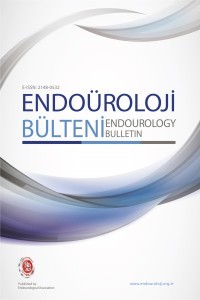Perkütan Nefrolitotomi Ameliyatında Taşsızlığın İntraoperatif Değerlendirilmesi: Cerrahın Gözü
böbrek taşları, perkütan nefrolitotomi, taşsızlık durumu, intraoperatif değerlendirme, cerrahın gözü
Intraoperative Assessment of Stone Free Status for Percutaneous Nephrolithotomy Surgery: Surgeon’s Eye
stones, percutaneous nephrolithotomy, stone-free status, intraoperative evaluation, surgeon’s eye,
___
- 1. Turk C, Petřik A, Sarica K, et al. EAU Guidelines on Interventional Treatment for Urolithiasis. Eur Urol 2016;69:475-82
- 2. Thomas K, Smith NC, Hegarty N, Glass JM. The Guy’s stone score—Grading the complexity of percutaneous nephrolithotomy procedures. Urology 2011;78: 277–81. https://doi:10.1016/j.urology.2010.12.026
- 3. Smith A, Averch TD, Shahrour K, et al. A nephrolithometric nomogram to predict treatment success of percutaneous nephrolithotomy. Journal of Urology 2013;190: 149– 56. https://doi.org/10.1016/j.juro.2013.01.047
- 4. Lehtoranta K, Mankinen P, Taari K, et al. Residual stones after percutaneous nephrolithotomy: sensitivities of different imaging methods in renal stone detection. Ann Chir Gynaecol 1995;84: 43–49.
- 5. Gokce MI, Ozden E, Suer E, et al. Comparison of imaging modalities for detection of residual fragments and prediction of stone related events following percutaneous nephrolitotomy. Int Braz J Urol 2015;41: 86-90. https://doi.org/10.1590/S1677- 5538.IBJU.2015.01.12
- 6. Emmott AS, Brotherhood HL, Paterson RF, Lange D, Chew B.H. Complications, Re- Intervention Rates, and Natural History of Residual Stone Fragments After Percutaneous Nephrolithotomy. J Endourol 2018;32:28-32. https://doi.org/10.1089/end.2017.0618
- 7. Wong, VKF, Que J, Kong EK, et al. The Fate of Residual Fragments after PCNL: Results from the EDGE Research Consortium. Journal of Endourology ja. (2023). https://doi.org/10.1089/end.2022.0561
- 8. Harraz AM, Osman Y, El-Nahas AR, et al. Residual stones after percutaneous nephrolithotomy: Comparison of intraoperative assessment and postoperative non- contrast computerized tomography. World J Urol 2017;35:1241–46. https://doi.org/10.1007/s00345-016-1990-4
- 9. Portis AJ, Laliberte MA, Holtz C, et al. Confident intraoperative decision making during percutaneous nephrolithotomy: Does this patient need a second look? Urology 2008;71: 218–22. doi:10.1016/j. urology.2007.08.063
- 10. Gokce MI, Gulpınar O, İbisA, et al. Retrograde vs. antegrade fl exible nephroscopy for detection of residual fragments following PnL: A prospective study with computerized tomography control. Int Braz J Urol 2019;45: 581-7. https://doi.org/10.1590/S1677- 5538.IBJU.2018.0695
- 11. Perez-Fentes DA, Gude F, Blanco M, Novoa R, Freire CG. Predictive analysis of factors associated with percutaneous stone surgery outcomes. Can J Urol 2013;20: 7050–59. PMID: 24331348
- 12. Nevo A, Holland R, Schreter E, et al. How Reliable Is the Intraoperative Assessment of Residual Fragments During Percutaneous Nephrolithotomy? A Prospective Study. J Endourol 2018;32:471-75. https://doi.org/10.1089/end.2018.0005
- 13. Noureldin YA, Elkoushy MA, Andonian S. Which is better? Guy’s versus S.T.O.N.E. nephrolithometry scoring systems in predicting stone-free status post-percutaneous nephrolithotomy. World J Urol 2015;33: 1821-25. doi:10.1007/s00345-015-1508-5
- 14. Vicentini FC, Marchini GS, Mazzucchi E, Claro JF, Srougi M. Utility of the Guy’s stone score based on computed tomographic scan findings for predicting percutaneous nephrolithotomy outcomes. Urology 2014;83: 1248–53. doi:10.1016/j. urology.2013.12.041
- Yayın Aralığı: Yılda 3 Sayı
- Başlangıç: 2020
- Yayıncı: ENDOÜROLOJİ DERNEĞİ
Harun ÖZDEMİR, Emin Taha KESKİN, Merve ŞAM ÖZDEMİR, Metin SAVUN, Halil Lütfi CANAT, Abdülmüttalip ŞİMŞEK
Pelvimetrik Ölçümlerin Açık Retropubik Radikal Prostatektomi Operasyon Süresi Üzerine Etkileri
Mustafa AYDIN, Lokman İRKİLATA, Mustafa Koray KIRDAĞ, Uğur ÖZTÜRK, Mehmet ÖZEN, Emrah KÜÇÜK, Hakan YILDIZ, Reha ORDULU, Mustafa Kemal ATİLLA
Perkütan Nefrolitotomi Ameliyatında Taşsızlığın İntraoperatif Değerlendirilmesi: Cerrahın Gözü
Mehmet Yiğit YALÇIN, Batuhan ERGANİ, Taha ÇETİN, Mustafa KARABIÇAK, Mert Hamza ÖZBİLEN, Çağdaş BİLDİRİCİ, Erkin KARACA, Mehmet YOLDAŞ, Erdem KISA, Tufan Suel ÖZGEN, Gökhan KOÇ, Özgür ÇAKMAK, Hayal BOYACIOĞLU, Yusuf Özlem İLBEY
Osman Raif KARABACAK, Fatih SANDIKÇI, Hakan SALTAŞ, Alper DİLLİ, Kürşad ZENGİN, Fatih YALÇINKAYA, Ümit Yaşar AYAZ
